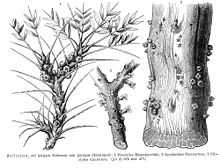Apodanthaceae
| Apodanthaceae | |
|---|---|
 | |
| Scientific classification | |
| Kingdom: | Plantae |
| (unranked): | Angiosperms |
| (unranked): | Eudicots |
| (unranked): | Rosids |
| Order: | Cucurbitales |
| Family: | Apodanthaceae |
| Genera | |
| |
The family Apodanthaceae comprises about 10 species of endoparasitic herbs. They live in the branches or stems of their hosts (as filaments similar to a fungal mycelium), emerging only to flower and fruit. The plants produce no green parts and do not carry out any photosynthesis (that is, they are holoparasitic).[1] There are two genera: Pilostyles and Apodanthes.[2] A third genus name that is sometimes erroneously listed was never validly published.[3] Mitochondrial and nuclear DNA sequences confidently place the Apodanthaceae in the Cucurbitales, where they also fit well in terms of their flower morphology.[4]
References
- ↑ Apodanthaceae: Family Description, Parasitic Plant Connection website, accessed 2009-12-31
- ↑ Albert Blarer, Daniel L. Nickrent, and Peter K. Endress. 2004. "Comparative floral structure and systematics in Apodanthaceae (Rafflesiales)". Plant Systematics and Evolution 245(1-2):119-142.
- ↑ Bellot, S., and S. S. Renner. 2013. "Pollination and mating systems of Apodanthaceae and the distribution of reproductive traits in parasitic angiosperms". "American Journal of Botany" 100(6): 1083–1094.
- ↑ Filipowicz, N., and S. S. Renner. 2010. "The worldwide holoparasitic Apodanthaceae confidently placed in the Cucurbitales by nuclear and mitochondrial gene trees." BMC Evolutionary Biology 10:219.